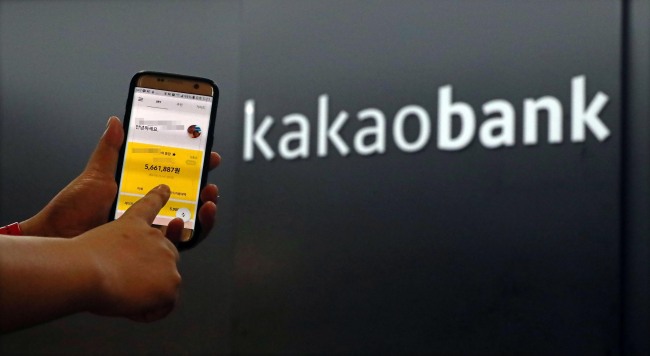More than 1.5 million bank accounts were created through Kakao Bank in its first week of operation, while the bank Thursday unveiled plans to address questions about its financial liquidity.
As of 7 a.m. Thursday, the second branchless bank in South Korea had nearly 1.52 million accounts created, while drawing 653 billion won ($579.2 million) in deposits and savings and extending 497 billion won in loans, according to the bank. It began service at 7 a.m. on July 27.
This is far-reaching compared to the performance of K bank, the nation’s first branchless bank. During the first four months of operations, K bank users made over 500,000 accounts, generating 690 billion won in deposits and borrowing 630 billion won, per data available Monday.
 |
(Yonhap) |
The data indicated Kakao Bank managed to stabilize capital liquidity by lowering the loan-to-deposit ratio -- used to assess a bank’s liquidity -- to 76.1 percent Thursday from 94 percent Monday. A lender with capital of more than 2 trillion won must limit the loan-to-deposit ratio to below 100 percent, but internet-only lenders are exceptions from the regulation designed to maintain a banking institution’s capital adequacy.
With actual debit cards now being delivered to users, the amount of deposits also began to surge as the week passed, said Jayden Hwang, an official of Kakao Bank. Currently, less than 7 in 10 users have applied for debit cards. One needs a debit card to physically withdraw cash from the account.
Kakao Bank also said it plans to cap the overdraft limit, currently at 150 million won per account.
Concerns about Kakao Bank’s risk management capability and excessive lending have emerged since its launch, citing K bank’s July suspension of signature credit for those with income, and the halt of overdrafts in mid-June. The loan-to-deposit ratio of K bank at the end of June amounted to 90 percent.
“(Kakao Bank’s) ability to manage credit risk amid changing interest rates needs to be verified,” wrote Oh Dong-hwan, an analyst at Samsung Securities, in a report Tuesday.
The fledgling bank’s customer service has also been criticized, with financial authorities saying the 250-strong customer service center was able to respond to just 14 percent of calls from customers as of Tuesday, lower than commercial banks’ response rate of 50-70 percent.
Kakao Bank said Thursday it was planning to hire 80 more staff members for the center and it was considering building another customer service center.
Kakao Bank garnered attention in its launch with more favorable interest rates in deposits and loans, in part through cost savings from not having a brick-and-mortar branch operation.
The bank offers 2 percent interest rates for time deposits and maximum 2.2 percent rates for installment savings accounts for a year. Meanwhile, credit loans and overdrafts are extended with minimum rates of 2.86 percent, the lowest among banks in Korea.
Moreover, the debit card issued by Kakao Bank does not charge an annual fee, unlike many conventional banks, while its customers pay 5,000 won for commission fees on overseas transfers of up to $5,000, one-tenth of the average of commercial banks.
Despite such favorable conditions for customers, Kim So-hye, an analyst at Hanwha Investment & Securities, wrote in a note that the online-only bank would not bring a seismic change to the banking industry in Korea, although it will be able to offer user-friendly experiences nonexistent for conventional banks, backed by the platform that messenger app KakaoTalk provides.
“Kakao Bank should be seen as a branch of an enormous platform of KakaoTalk, rather than a stand-alone banking entity,” she wrote.
By Son Ji-hyoung (
consnow@heraldcorp.com)







![[Today’s K-pop] Blackpink’s Jennie, Lisa invited to Coachella as solo acts](http://res.heraldm.com/phpwas/restmb_idxmake.php?idx=644&simg=/content/image/2024/11/21/20241121050099_0.jpg)
